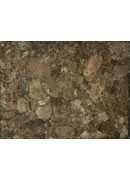Jean Dubuffet
让•杜布菲
法国画家

Dubuffet was born in Le Havre. He moved to Paris in 1918 to study painting at the Académie Julian, but after six months he left the Académie to study independently. In 1924, doubting the value of art, he stopped painting and took over his father's business selling wine. He took up painting again in the 1930s, when he made a large series of portraits in which he emphasized the vogues in art history. But again he stopped, only turning to art for good in 1942 when he started to paint figures of nude women in an impersonal and primitive way, in strong and unbroken colours. He chose as subjects people in the commonplace of everyday life, such as people sitting in the Paris Métro, or just walking in the country. His first solo show came in 1944.
In 1945 he was strongly impressed by a show in Paris of Jean Fautrier's paintings in which he recognized meaningful art which expressed directly and purely the depth of a person. As did Fautrier he started to use thick oil paint, but mixed with sand and gravel, by which he could model the paint as a skin of the painting. This resulted in the series 'Hautes Pâtes', which he exhibited in 1946 at the Galérie René Drouin. After 1946 he started a series of portraits, with as 'model' partly his own friends Henri Michaux, Francis Ponge, Jean Paulhan and Pierre Matisse. He painted these portraits in the same thick materials, and in a manner deliberately anti-psychological and anti-personal, as Dubuffet expressed himself. A few years later he approached the surrealist group in 1948, then the College of Pataphysique in 1954. He was friendly with the French playwright, actor and theater director Antonin Artaud, he admired and supported the writer Louis-Ferdinand Céline and was strongly connected with the artistic circle around the surrealist André Masson. In 1944 started an important relation with the resistance-fighter and French writer, publisher, Jean Paulhan who was also strongly fighting against 'intellectual terrorism', as he called it.
Influenced by Hans Prinzhorn's book Artistry of the Mentally Ill, Dubuffet coined the term art brut (meaning "raw art," oftentimes referred to as ‘outsider art’) for art produced by non-professionals working outside aesthetic norms, such as art by psychiatric patients, prisoners, and children. He amassed his own collection of such art, including artists such as Aloïse Corbaz and Adolf Wölfli. The collection is now housed at the Collection de l'art brut in Lausanne, Switzerland.
Dubuffet sought to create an art as free from intellectual concerns as Art Brut, and his work often appears primitive and childlike. Nonetheless, Dubuffet appeared to be quite erudite when it came to writing about his own work. According to prominent art critic Hilton Kramer, "There is only one thing wrong with the essays Dubuffet has written on his own work: their dazzling intellectual finesse makes nonsense of his claim to a free and untutored primitivism. They show us a mandarin literary personality, full of chic phrases and up-to-date ideas, that is quite the opposite of the naive visionary."
Many of Dubuffet's works are painted in oil paint using an impasto thickened by materials such as sand, tar and straw, giving the work an unusually textured surface. From 1962 he produced a series of works in which he limited himself to the colours red, white, black, and blue. Towards the end of the 1960s he turned increasingly to sculpture, producing works in polystyrene which he then painted with vinyl paint.
In late 1960–1961, Dubuffet began experimenting with music and sound and made several recordings with the Danish painter Asger Jorn, a founding member of the avant-garde movement COBRA. The same period he started making sculpture, but in a very not-sculptural way. As his medium he preferred to use the ordinary materials as papier mâchier and for all the light medium polystyrene, in which he could model very fast and switch easily from one work to another, as sketches on paper. At the end of the 1960s he started to create his large sculpture-habitations, such as 'Tour aux figures', 'Jardin d'Hiver' and 'Villa Falbala' in which people can wander, stay, and contemplate. In 1969 ensued an acquaintance between him and the French Outsider Art artist Jacques Soisson.
In 1978 Dubuffet collaborated with American composer and musician Jasun Martz to create the record album artwork for Martz’s avant-garde symphony entitled The Pillory. The much written about drawing has been reproduced internationally in three different editions on tens-of-thousands of record albums and compact discs. A detail of the drawing is also featured on Martz’s second symphony (2005), The Pillory/The Battle, performed by The Intercontinental Philharmonic Orchestra and Royal Choir.
One of Dubuffet's later works was Monument With Standing Beast (1984). Dubuffet died in Paris in 1985. The Fondation Jean Dubuffet collects and exhibits his work. The Dubuffet Foundation is represented by The Pace Gallery, New York.
In early 2012 the Pace Gallery mounted an exhibition of work from the last two years of Dubuffet's life. Writing to Arne Glimcher, in a letter reproduced in the catalog for the exhibition, Dubuffet explained his conception for the paintings as “intended to challenge the objective nature of being. The notion of being is presented here as relative rather than irrefutable: it is merely a projection of our minds, a whim of our thinking. The mind has the right to establish being wherever it cares to and for as long as it likes. There is no intrinsic difference between being and fantasy.”












